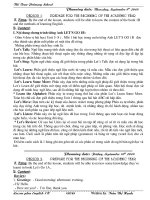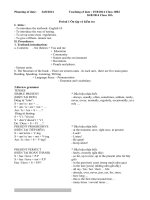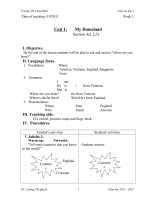- Trang chủ >>
- Mầm non - Tiểu học >>
- Lớp 4
giáo án tiếng anh lớp 4 toàn tập
Bạn đang xem bản rút gọn của tài liệu. Xem và tải ngay bản đầy đủ của tài liệu tại đây (173.21 KB, 41 trang )
Week 3
Period 9
UNIT2: I’M FROM JAPAN
Lesson 1: part 3-4-5
I. Objectives: After the lesson, students are able to:
- Asking where someone is from.
- Respond to the question. Listen for specific information.
- Skills: Listening, writing, reading and speaking.
II. Language contents:
- Vocabulary: England; America; Australia; Vietnam; Malaysia; Japan
- Grammar
: Where are you from?
- I’m from.....
III. Teaching aids:
-
Teaching aids: recording,
-
Resources: student’s book , workbook
IV. Procedures.
1. Class organization:
- Greeting
- Checking for the students' attendance.
2. Oral test:
- Have pupils ask and answer questions about someone, intro-duce someone.
3. New lesson
Teacher ’s work
Warm up
- Have Ss play the game:
Noughts and Crosses
Students’ activities
- Play the game in groups.
nice
how
It’s
3. listen and tick
- Ask ss to look at the part 3 on page 13 and
answer the questions.
- Identify the characters.
+ How many pictures are there?
+ What can you see in each picture?
- Get ss call out the names of the things and the
countries they are symbolized for in each picture.
- Indentify the characters in
each picture. Guess the answer.
- Ask ss to guess the correct picture in each
number.
- Get the students’ answer
- Elicit to help ss know how to do this part.
- Set the scene: Now you are going to listen to
the recording and you have to match the
information you hear to the pictures and tick the
correct boxes below the pictures.
- Ps listen & tick the boxes.
Check their guess. Compare the
answer with the partner.
Listen and check
Answer: 1.c
2.b
3.c
- Play the recording all the way through for ss to
listen while they are looking closely at the
pictures in their books.
- Play the recording again and get ss listen and
tick in the correct boxes below each picture.
- Have ss work in pairs to compare their
answers.
- Call some ss to give their answers
- Ask ss to listen again and check
- Replay the recording
- Get feedback from ss and give correct answer.
- Ask some questions to ensure pupils’
comprehension of the listening text.
Check some pairs.
- Listen and remember.
Transcript:
1. Tony: Hi. I’m Tony.
Hakim: Hello, Tony. I’m Hakim.
Tony: Nice to meet you,
Hakim.Where are you from?
Hakim: I’m from Malaysia
2. Quan: Hi. My name’s Quan
Tom: Hello, Quan. I’m Tom. Nice to
meet you.
Quan: Where are you from, Tom?
Tom: I’m from America.
3. Akiko: Hi! My name’s Akiko.
Linda: Hello Akiko!. I’m Linda. Nice
to meet you!
Akiko: Where are you from Linda?
Linda: I’m from England
Key: 1. I’m from Australia
4. look and write
2. I’m from Malaysia
- Ask ss to look at part 4 on page 13
3. I’m from America
- Get ss look at the pictures and call out the
names of the ss and where are they from basing
on the flag..
4. I’m from Japan
? How many pictures are there?
? Who is he/ she in each picture?
? Look at the flag, where is he/ she from?
? Are these sentences completed?
- Set the time limits for pupils to do the task.
- Have ss compare their answer with their
partners.
- Call three ss to come to the board and write
down the answer while other ss read aloud the
sentences.
- Get feedback from ss.
5- Let’s sing
- Get ss read aloud the song one time
- Play the recording for ss to listen while they
are reading the song.
- Get ss listen and repeat each line of the song
twice the second time.
- Have ss point to the sentences as they repeat
Conclusion and homework
- Ask Ss to do A, B at home.
Week 3
Period 10
UNIT2: I’M FROM JAPAN
Lesson 2: part 1-2-3 (page 14)
I. Objectives: After the lesson, students are able to:
- Ask and answer questions about one’s nationality”.
- Listen and read for specific information.
- Skills: Listening and speaking.
II. Language focus:
- Vocabulary: nationality, American, Malaysian, Japanese, English, Australian.
- Sentence patterns: What nationality are you? - I’m...+ nationality
III. Teaching aids:
1. Teacher’s: student’s and teacher’s book, pictures, cassette.
2. Students’: books, notebooks, workbooks.
IV. Procedures
1. Class organization:
- Greeting
- Checking for the students' attendance.
2. Oral test:
- Have pupils ask and answer questions about someone, intro-duce someone.
3. New lesson
Teacher ’s work
Students’ activities
Warm up:
- Have ss play the game: Jumbled letters.
- Play the game:
+ Show ss words in which all the letters have got
mixed up.
Chian
China
Vienatm
Vietnam
+ Have ss put the letters in the correct order to
make a word.
Jpaan
Japan
+ Call ss to give the answer.
Engandl
England
- Have ss read aloud all words.
Amrieac
1. Look, listen and repeat.
- Read in chorus.
America
Have Ss to look at the book at page 14.
Elicit the character and have Ss guess what
they are saying.
Look at the pictures in the
Set the scene: we are going to ask and answer book
questions about one’s nationality.
Have Ss listen to the recording as they read the
lines in the speech bubbles
Play the recording again for Ss to repeat the
lines in the speech bubbles two times.
Listen and repeat
Divide the class into two groups. One repeat
Mai’s part and the other repeat Nam’ part.
Play the recording again for the whole class to
repeat each line in the speech bubbles to
reinforce their pronunciation.
- Read in groups.
- Read in pairs.
Teach vocabulary:
Nationality: Quốc tịch
American: Người Mỹ
Malaysian: Người Mã Lai
Japanese: Người Nhật
- Read after T. Then note
down
English : Người Anh
Australian: Người Úc
Vietnamese: Người Việt Nam
- Identify the people.
- Sentence: What nationality are you?- I’m...
2. Point and say
- Have ss look at the picture and identify the
characters.
- Say: “You are going to practice answering the
question What nationality are you? - I’m...
- Listen to the T.
- Practice in pairs.
- 6-7 pairs. Others observe
- Do picture a as a model.
and comment.
- Have Ss work in pairs to practice.
- Call some pairs to talk in front of the class.
3. Let’s talk
Have Ps work in pair to ask and answer
questions:
+ What’s your name?
+ Where are you from?
+ What nationality are you?
Listen and correct.
Reinforcement and home link:
- Ask Ss to do Ex in Part E.
- Ss work in pairs.
- Some Ss volunteer come to
the class, the other give the
comment.
WEEK 3
Period 11
UNIT 2: I ’ M FROM JAPAN.
Lesson 2: Part 4, 5, 6
(Page 15)
Objectives:
I.
By the end of the lesson, students will be able to get further practice in asking and
responding the question about. What nationality someone is through the activities:
listen and number, look and write and play game.
II.
Language focus:
2. Vocabulary: countries and nationalities.
3. Grammar:
III.
IV.
What nationality are you? – I’m + nationality
Resources: Teacher’s book, students’ book, CD, stereo, pictures, puppets.
Procedure:
Teacher ’s activities
1- Warm up
Student’s activities
Individuals
a. Class organization .
- Ask a student some questions in Vietnamese
+ What’s the date to day?
+ Who’s absent today?
b. Game
- Prepare 12 cards, each with a country on one
side, and equal number of cards, each with a
nationality of the country.
- Ask ss to work in groups of six.
- Give each group a set of cards. Each group
should shuffle the cards and distribute them
face down on the table. Each player in turn
select two cards and turn them face up. If they
show a country and a nationality which match,
that player wins the pair and continue to turn
over another pair. If the cards do not match,
they are turned face down again and the next
player has a go. The game ends when all the
Group work
cards are gone. The winner is the player with
the most cards.
Vietnam
America
Malaysia
England
Australia
Japanese
Vietnamese
American
Australian
English
2- Listen and number
Individuals
-Ask ss to look at the part 4 on page 15 and
answer the questions
+ How many pictures are there?
+ Who are the characters in the pictures?
+ Where is he/ she from?
+ What nationality is he/she?
- Ask ss to guess to number the pictures in the
correct order.
TWC
- Collect students’ ideas
- Elicit to help ss know how to do this part.
- Set the scene: Now you are going to listen to
the recording and you have to match the
information you hear to the pictures and
number the pictures.
Individuals
- Play the recording all the way through for ss
to listen while they are looking closely at the
pictures in their books.
Pair work
Individuals
- Play the recording again and get ss listen and
number in the boxes below each picture.
TWC
- Have ss work in pairs to compare their
answers.
- Call some ss to give their answers
- Ask ss to listen again and check
- Get feedback from ss and give correct answer.
Key: 1.b
2.d
3. a
4. c
Transcript:
1. Hakim: Hello. I’m Hakim.
Mai: Hi, Hakim. I’m Mai. Nice to meet you.
Hakim: What nationality are you, Mai?
Mai: I’m Vietnamese
2. Linda: Hello. I’m Linda.
Hakim: Hi, Linda. I’m Hakim.
Linda: Nice to meet you, Hakim. Where are
you from?
Hakim: I’m from Malaysia
3. Linda: Hello. I’m Linda.
Tony: Hi, Linda. Nice to meet you. My
name’s Tony.
Linda: What nationality are you, Tony?
Mai: I’m Australia
4. Nam: Hello. I’m Nam. What’s your name?
Akiko: My name’s Akiko
Nam: Nice to meet you. What nationality are
you?
Mai: I’m Japanese.
- Ask ss some questions to check their
comprehension of the listening text.
Individuals
3- Look and write
- Ask ss to look at the book in part 5 on page 9
and answer the questions:
Individuals
? How many pictures are there?
? Are they completed?
? Who is he/she?
? Where is he/she from?
? What nationality is he/she?
- Have ss look at the pictures and read the
gapped sentences in silence.
- Use the first picture as an example.
- Ask ss to work individually and read aloud the
given sentences and phrases.
- Check students’ comprehension.
- Ask ss to work individually, read the sentences
again to get information and complete the
dialogues basing on the picture cues.
Individuals
- Monitor and offer help when necessary.
- Have ss compare their answer with partner.
Pair work
- Call on some ss to report their answers.
- Get feedback from ss and give correct answers.
* Key: 2. America, American
3. England, English
4. Japan, Japanese
- Make a few questions to check students’
comprehension.
- Ask ss to read aloud the sentences and
reinforce students’ pronunciation.
TWC
4-Let’s play: FIND SOME ONE WHO …
- Ask ss to play game: Find someone who …
- Prepare equal numbers of cards with the
following words: America, Australia, England,
Malaysia, Viet Nam and Japan. The total
number of cards should be equal to or more
than the number of students. Then mix the
cards up and deliver one to every individual in
the class. The cards represent where the
students are from.
- Tell the student to choose a country. They
should talk to their classmates and try to find
one who is from the country they have chosen.
Individuals
Pair work
Individuals
- When everyone has found a classmate from
the country of their choice, call a few to
introduce themselves and their partners, by
saying the countries they are from and their
nationalities
e.g: I’m Ha. I’m from England. I’m English.
Linh is from America. She’s American.
- Check as a class and correct pronunciation, if
necessary
- Guide ss to do exercise in workbook
- Prepare for the next lesson:
TWC
Unit 2: I’m from Japan ; Lesson3; Part 1,2,3
Week 3
Period 12
UNIT 2: I’M FROM JAPAN
Lesson 3: part 1-2-3 (page 16)
I. Objectives: After the lesson, students are able to:
- Pronounce correctly the sound of the letters “j, v”.
- Say what nationality they are.
- Listen and read for specific information.
- Skills: Listening and reading.
II. Language focus:
- Phonics: j, v
- Vocabularies: Countries and nationalities
- Grammar:
Where are you from? – I’m from + countries
What nationality are you? - I’m + nationality
III. Teaching aids:
1. Teacher’s: student’s and teacher’s book, pictures, cassette.
2. Students’: books, notebooks, workbooks.
IV. Procedures :
1. Class organization:
- Greeting
- Checking for the students' attendance.
2. Oral test:
- Have pupils ask and answer questions about someone, introduce someone.
3. New lesson
Teacher ’s work
Students’ activities
Warm up
- Have Ss play the game:
Slap the board.
Japanese
From
- Work in groups to play the
game.
Japan
Malaysia
Malaysian
1. Listen and repeat.
- Let Ss pay attention to the letters cultured
differently.
- Identify: Japan, Vietnamese
- Have Ss learn to produce the sound of the
letters “ J, V ” in the words Vietnamese,
Japan
- Pay attention.
- Play the tape and ask Ss to listen.
- Listen.
- Play the tape again and ask Ss to repeat each
line of the text in chorus.
- Listen and repeat.
- Have Ss read in groups/ in pairs.
2. Listen and tick. Then say aloud
- Have Ss look at the words in part 2 (p. 16) to
identify where they are and set up the task.
- Read in groups./ in pairs.
- Look and read the words.
- Play the recording 2 times pupils to listen and - Guess the answer
tick the boxes.
- Listen and tick the words
- Play the recording again pupils check their
they hear. Check their guess.
answers.
Compare the answer with the
partner.
- Check and correct.
1.a
2. b
- Have some ss retell.
3. Let’s chant.
- Get ss to listen to the chant.
- Play the recording all the way through for ss to
listen when they are reading the chant on the
board or on their book.
- Play the recording for the ss to repeat the lines
twice.
- Play the recording a few times for ss to do
choral and individual repetition.
-
Listen and repeat.
Reinforcement and home link:
- Do at home.
- Ask Ss to do exercises in C, D (p.6/WB) at home.
Comments:
……………………………………………………………………………………………………………………
……………………………………………………………………………………………………………………
……………………………………………………………………
BAN GIÁM HIỆU KÝ DUYỆT
Ngày……tháng…..năm 2015
Week 4
Period 13
UNIT 2: I’M FROM JAPAN
Lesson 3: part 4-5-6 (page17)
I. Objectives: After the lesson, students are able to:
- Say what nationality they are.
- Listen and read for specific information.
- Skills: reading and writing.
II. Language focus:
1. Vocabulary: countries and nationalities.
2. Grammar:
Where are you from? – I’m from + countries
What nationality are you? - I’m + nationality
III. Teaching aids:
1. Teacher’s: student’s and teacher’s book, pictures, cassette.
2. Students’: books, notebooks, workbooks.
IV. Procedures :
1. Class organization:
- Greeting
- Checking for the students' attendance.
2. Oral test:
- Have pupils ask and answer questions about someone’s nationality
3. New lesson
Teacher ’s work
Students’ activities
Warm up:
- Play the game:
- Have ss play the game: Jumbled letters.
layMsiana
Malaysian
+ Show ss words in which all the letters have got
mixed up.
Vienatmees
Vietnamese
Jpaesean
Japanese
Amrieacn
American
+ Have ss put the letters in the correct order to
make a word.
+ Call ss to give the answer.
- Have ss read aloud all words.
4. Read and complete
T guides Ss how to do the exercise.
-Ask students to read the text in part 4 (page 17)
and fill the words given to complete the table.
- Read the text individually
and do the task.
Correct the pronunciation.
- Check in peers.
Answer: Tony: Sydney/Australia/Australian
- One reports the answer. The
rest of the class listen and
give comments.
Linda: Lodon/ England/ English
Tom: Newyork/ America/American
5. let’s write
- Look at the sentences and
- Have pupils look at the sentences and guess the guess the suitable words to
suitable words to fill.
fill.
- Call on some Ss to report the answers.
- Some Ss reports the answer.
- Guide ss to complete the exercise.
- Complete the exercise
individually.
- Have ss read aloud the words they have written.
- Check and correct.
- 7-8 Ss read aloud, others
listen and give comment.
- Read in pairs.
6. Project
- Have Ss look at the name card.
- Ask ss to prepare necessary school things to
carry out the project (paper, pen, ruler, pencils,
scissors, glue ….) then make their own name cards
with teacher’s help
- choose the country they like
- Show to classmates their
name cards and present about
that
- Select three best cards and award the students
with small prizes
- Check and correct.
Reinforcement and home link:
- Ask Ss to do Ex in the workbook.
- Prepare for the next lesson:
Unit 3. What day is it today? Part 1,2,3
- Complete the exercise
individually.
Week 4
Period 14
Unit 3: WHAT’S DAY IS IT TODAY?
Lesson 1: part 1-2-3 (page 18)
I. Objectives: After the lesson Ss will be able to:
- Ask and answer questions about days of the week.
- Listen for specific information.
- Skills: speaking, listening.
II. Language focus :
- Vocabulary: Monday, Tuesday, Wednesday, Thursday, Friday, Saturday, Sunday.
- Sentence patterns: - What day is it today? - It is Monday.
III. Teaching aids:
1. Teacher’s: student’s and teacher’s book, pictures, cassette.
2. Students’: books, notebooks, workbooks.
IV. Procedures
1. Class organization:
- Greeting
- Checking for the students' attendance.
2. Oral test:
- Have pupils asking and answering about their nationality.
3. New lesson:
Teacher ’s work
Warm up: - Say chatting.
Students’ activities
- Respond
2. Look , listen and repeat
- Have ss look at the picture & identify
the characters and what they are doing.
- Introduce the dialogue: They are going
to listen to children & Miss Hien talking
about days of the week.
- Play the CD for the ss.
- Identify the characters.
- Look and Listen.
- Play again, have ss listen and repeat,
focus on some words.
- Present the way to ask questions about
days of the week.
- Have ss read the dialogue.
- Check some groups.
2. Point and say
- Listen and repeat.
- Listen and repeat. Pay attention to
day, today, Monday.
- Listen and note down:
- What day is it today? -It is Monday.
- Read and check.
- Have ss look at the picture and identify
days of the week.
- Give the meaning of new words.
- Have ss practice reading new words.
- Identify.
- Call some ss to read.
- Do the task with a student and then
- Note down.
Have ss work in pair ask and answer
about days of the week.
Monday Tuesday
Wednesday
Thursday Friday Saturday
Sunday
- Check ss.
3. Listen and tick.
- Have Ss look at the pictures in N 4 to
identify days of the week.
- Read in chorus.
- Read before the class.
- Practice speaking.
- Ask Ss to listen and tick.
- What day is it today? - It is.....
- Have ss listen again and check.
- Act it out and correct.
- Call on some students to report the
answers to the class.
- Identify.
- Check and correct.
- Listen and check.
Reinforcement and home link:
-Listen and do the task.
- Practice in pairs.
- Have ss play the game: Matching.
- Give out and check: 1a; 2a; 3b;
- Look and match:
Monday
Chủ nhật
Friday
Thứ hai
Thursday
- Ask Ss to do A, B at home.
Thứ bảy
aturday
Thứ ba
Sunday
Thứ tư
Wednesday
Thứ năm
Tuesday
Thứ sáu
- Do at home.
Week: 4
Period: 15
Unit 3: WHAT’S DAY IS IT TODAY?
Lesson 2: part 1-2-3
I. Objectives: After the lesson, students are able to:
- Ask and answer the questions about weekly activities.
- Complete the timetable of their own.
- Skills: speaking.
II. Language focus:
- Vocabulary: English.
: What do you do on (name of the day)?
- Sentence patterns
I... in the morning/ in the afternoon...
III. Teaching aids:
1. Teacher’s: student’s and teacher’s book, pictures, cassette.
2. Students’: books, notebooks, workbooks.
IV. Procedures
1. Class organization:
- Greeting
- Checking for the students' attendance.
2. Oral test:
- Have pupils say about days of the week.
3. New lesson:
Teacher ’s work
Students’ activities
Warm up:
- Have ss sing the song on page 19.
- Sing in chorus.
- Call some ss to sing.
- Give out and check.
- Check.
1. Look, listen and repeat.
- Have ss look at the picture & identify the
characters and what they are doing.
- Identify the characters.
- Introduce the dialogue: They are going to
listen to children & Miss Hien talking about
days of the week.
- Look and Listen.
- Play the CD for the ss.
- Play again, have ss listen and repeat, focus
on some words.
- Listen and repeat.
- Present the way to ask questions about
weekly activities.
- Listen and repeat. Pay attention
to next, English, home.
- Have ss read the dialogue.
- Listen and note down:
- Check some groups.
- What do you do on......? – I......
2. Point and say
- Read and check.
- Have ss look at the picture and identify the
activities and days of the week.
- Give the meaning of new words.
- Have ss practice reading new words.
. - Identify.
- Call some ss to read.
- Do the task with a student and then
Have ss work in pair ask and answer about
weekly activities.
- Listen and repeat after the T.
- Note down.
visit
parents
- Check ss.
- Read in chorus.
3. Let’s talk
- Read before the class.
- Say: “You are going to practice answering
the question “What day is it today?
- Practice speaking.
What do you do on Monday/ Tuesday....?
- Have Ss work in pairs to practice.
- Call some pairs to talk in front of the class.
Reinforcement and home link:
- Say days of the week.
- Ask Ss to do Ex in Part E.
- What do you do on....? - I.....
- Act it out and correct.
- Look and pay attention.
- Work in pair.
- 6-7 pairs. Others give comment.
- Say in chorus.
- Do at home.
Week: 4
Period: 16
Unit 3: WHAT’S DAY IS IT TODAY?
Lesson 3: part 1-2-4
I. Objectives: After the lesson, students are able to:
- Pronounce correctly the sound of the letters “ir” and “ur” “er”.
- Listen and read for specific information.
- Skills: listening, reading.
II. Language focus:
- Vocabulary: Days of the week
- Sentence patterns
:
- Phonics: the letters “ir” and “ur”: er”.
III. Teaching aids:
1. Teacher’s: student’s and teacher’s book, pictures, cassette.
2. Students’: books, notebooks, workbooks.
IV. Procedures
1. Class organization:
- Greeting
- Checking for the students' attendance.
2. Oral test:
- Have pupils say about weekly activities.
3. New lesson:
Teacher ’s work
Students’ activities
Warm up
- Have Ss play the game:
- Work in groups to play the game.
Friday
Slap the board.
Sunday
Monday
Thursday
Saturday
Tuesday
Wednesday
1. Listen and repeat.
- Have Ss look at words in part 1.
- Identify:
- Let Ss pay attention to the letters cultured.
- Pay attendant.
- Have Ss learn to produce the sound of the
letters “ ir” and “ur” “er” .
- Listen.
- Play the CD and ask Ss to listen.
- Play the CD again and ask Ss to repeat
each line of the text in chorus.
- Listen and note.
- Repeat.
- Have Ss read in groups/ in pairs.
- Check some ss.
2. Listen and circle. Then write and say
aloud.
- Read in groups./ in pairs.
- Give out and check.
- Have pupils look at the sentences and
guess the suitable words to circle .
- Play the recording 2 times pupils to listen
and circle.
- Read 3 sentences
- Play the recording again pupils check their - Listen and circle.
answers. T give the answer:
Check their guess. Compare the
- Have pupils to write on the boad the answer with the partner.
sentences.
- Check and correct.
4. Read and answer.
- 4 Ss. The rest of the class writes
in the notebooks.
- Have Ss read and do the task.
Keys: 1. a
Set the scene: “you are going to read the
questions and find out the answer.”
- Ask Ss to read the questions and answer
2. b 3.b
- Read and do the task in pairs.
Monitor the activity and offer help when - Ss trade the answers in pairs for
necessary
correction
Call on some Ss to report their answers.
Make a few questions to check
comprehension of the sentences.
Ss’
- Read the questions and answers
Have the whole class read each sentence in pairs( 5-6 pair). The rest of the
in chorus to reinforce their pronunciation
class listen and give comments.
Reinforcement and home link:
Answer: 1. Her name is Mai.
Play recording a song: We have English day
2. It’s Monday. 3. No, she doesn’t
- Ask Ss to do exercises in C, D (WB) at
home.
4. She goes swimming and.....
- Ss listen and repeat.
- Do at home.
Week: 5
Period: 17
Unit 3: WHAT’S DAY IS IT TODAY?
Lesson 1-2: part 4-4-5
I. Objectives: After the lesson Ss will be able to:
- Ask and answer questions about days of the week, weekly activities.
- Listen for specific information.
- Skills: writing, listening.
II. Language focus :
- Vocabulary: Monday, Tuesday, Wednesday, Thursday, Friday, Saturday, Sunday.
- Sentence patterns: - What day is it today? - It is Monday.
III. Teaching aids:
1. Teacher’s: student’s and teacher’s book, pictures, cassette.
2. Students’: books, notebooks, workbooks.
IV. Procedures
1. Class organization:
- Greeting
- Checking for the students' attendance.
2. Oral test:
- Have pupils asking and answering about their weekly activities.
3. New lesson:
Teacher ’s work
Warm up: - Say chatting.
Students’ activities
- Respond
4. Look and write
- Have pupils look at the sentences and - Look at the sentences and guess the
the table (p19) then guess the suitable suitable words to fill.
words to fill.
- Complete the exercise individually.
- Call on some Ss to report the answers .
- Read aloud. The rest of the class
- Guide ss to complete the exercise.
listen and give comments.
- Have ss read aloud the sentences they
- Whole class.









